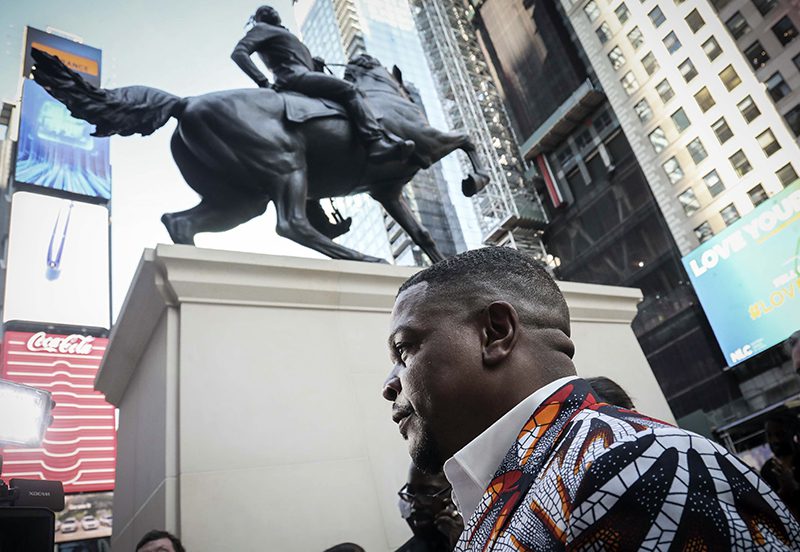Artist Kehinde Wiley On What We Can Do With Offensive Art

Visual artist Kehinde Wiley, best known for his portrayals of contemporary African-American and African-Diasporic individuals, appears at the unveiling his first monumental public sculpture “Rumors of War,” an equestrian portraiture of warfare and heroism, Friday Sept. 27, 2019, in New York. The work will be exhibited in Times Square through December 1. (AP Photo/Bebeto Matthews)
NEW YORK (AP) — As the nation debates what to do with civic statues that glorify slavery and white supremacy, one artist has a solution. Kehinde Wiley wants more art.
Wiley, who was tapped to paint Barack Obama for the National Portrait Gallery, thinks monuments to Confederate figures need to be placed in their social context, not torn down.
The artist was in Times Square last week to offer his latest corrective, unveiling a massive bronze statue of a young African American man in urban streetwear sitting astride a galloping horse. Called “Rumors of War,” the eight-ton, 29-foot-high work mimics a statue in Richmond, Virginia, of a Confederate general and will be moved there at the end of the year.
Wiley is known for his regal portraits of minorities, which reclaim a privilege long reserved for white aristocrats. He has explained that his work is a remedy for the historical invisibility of black men and women.
One recent exhibition depicts 15 African Americans from Ferguson, Missouri, and its neighboring communities, dressed in their own clothes but posed like subjects in a classical painting. It is the artist’s memorial to Mike Brown, a young man shot to death by police.
In the shadow of his massive Times Square addition, Wiley told The Associated Press about his thoughts on Confederate monuments, if he’s become more political and where he goes from here.
Q: There are many people who think Confederate monuments like the ones in Virginia should be ripped down. You’re offering another alternative _ more art. Should art answer art?
A: I believe that when dealing with a troubled past and arguably a beautiful future, artists should use every tool in their wheelhouse. What I try to do is I say yes to certain aspects of history. And I say no to others. What we’re saying yes to here is monumentally, romanticism, the love of sculpture, the love affair with the body. This is something that I think is beautiful, but I don’t want to necessarily use the negative aspects of America’s history as a means through which you view this work. I think promise is the leading edge of this work.
Q: Do you think the Confederate monuments should be taken down? If you do, as an artist, does that put you in a strange position?
A: I’ve never personally asked for any art to be taken down. I actually believe that all art should be seen within its own social context. There must be a museum for all of the terrible ideas that exist in the world. The only thing that battles a bad idea is a better idea.
Q: Are you getting any more political or socially active with your work?
A: It’s so interesting. So many people have been wondering what Kehinde Wiley would be making after the Obama portrait. This is my first shot out of the cannon in America and it’s no more political than anything I’ve ever done. What I deal with is history. I deal with Europe and America and colonialism and empire and I try to find new ways of digesting that content, trying to find new ways of looking at ourselves anew. It’s not about blackness. It’s not about whiteness. It’s about the co-evolution of societies and culture and what you’re looking at is us. In full measure.
Q: You keep growing, going from paintings of young men to ones of women, from Americans to people in Indian and Brazil. Where do you want to go?
A: There is no limit. There’s no limit to the creative possibility of young people. There’s no limit to the place in which hip-hop has found itself in the bedrooms of young dreamers who want to figure out how they can tell their stories. As long as I have breath in my life, I’m going to dedicate myself to tear up telling those stories.
Q: In your paintings, you used wallpaper and tapestries to show privilege. In sculpture, you can’t. How have you adjusted to three-dimensional works?
A: What I do in my own work here with regards to sculpture is to allow the city to be the backdrop, to allow a moving and constantly changing America to be the context in which we see this young man riding a massive horse in the middle of Times Square, soon to be in the middle of Virginia. How does that hack the mind of the young viewer? How does that hack the mind of the artist who’s thinking about what they want to do in their work?
___
Mark Kennedy is at https://twitter.com/KennedyTwits
No Comments